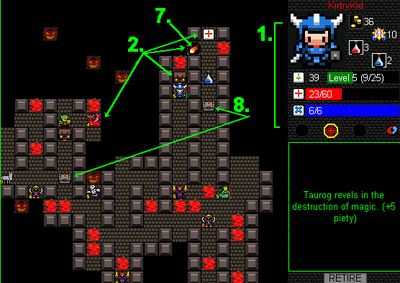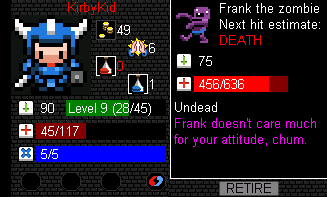Apparently, I really like roguelikes. Spelunky. Ro9. Shiren (part platformer, puzzle game, adventure/strategy game respectively). Recently I stumbled across Desktop Dungeons, which has a very table top, dice rolling, D&D feel. In this game there aren't enough sound effects, musical tracks, or special visual effects. In fact there aren't any animations whatsoever. And I love it. After all, I usually play Advance Wars without sound and with the animations turned off. So I'm used to focusing entirely on the gameplay. Expressing the difference between Shiren and Desktop Dungeons (DD) takes nothing short of the precise critical language we should all be familiar with by now.

To recap, the genre defining features of a roguelike generally include randomly generated levels, turn based combat, and permadeath. Desktop Dungeons has all 3. In addition, roguelikes typically employ some kind of RPG leveling/stats system and collectible items. With stats and invisible spreadsheets making up the core of RPG systems, we can say that simple mathmatical, tactical optimization dominates the gameplay. In other words, attack-attack-heal is the dominant tactic/strategy where one attacks with their most powerful attack(s) while healing only to maintain the offensive. This kind of approach is obvious even to fledgling RPG gamers. There's really nothing to it. So, one way to thoroughly enjoy different RPGs systems is to devise very efficient strategies. At the same time, developers tend to obscure and/or restrict the most optimal options behind abilities, levels, items, and other highly abstract mechanics. Mastering these kinds of systems likes time.
What good roguelikes do especially well is take the joy of mastering an RPG system and greatly reduce the static space of grinding for levels or repeating the same moves algorithmically/mindlessly. The randomly generated levels of good roguelikes stress adaptation skills making each experience unique and engaging. The permadeath makes each decision count. When you can't load from a save or retry in any capacity, small mistakes can ripple forward into large consequences. And big mistakes are generally fatal. With this design the fear of loss is always present creating tension. Finally, the turn based gameplay gives you plenty of time to think about every move you make and the many potential consequences eliminating real times skills (reflex, timing, dexterity) and greatly stressing knowledge.
Perhaps we should add two more defining features to the roguelike genre; suspension and decay (article2). Permadeath transforms the overall process of trial and error in a roguelike. Normally, trial and error is a problem solving methodology for leaning a one problem/challenge at a time. When you die in a roguelike, almost everything gets reset back to "factory default" settings. Yet, it's not uncommon for roguelikes to allow players to suspend some part of one play through into another. Whether it's a game+ feature, leaving items behind in storehouses (Shiren), paying for shortcuts (Spelunky), or having the Anks of one adventurer resurrect another (Ro9), suspended design elements are sort of highlighted by the permadeath feature.
Furthermore, decay is a feature that is highlighted by the turn based and/or randomly generated design features. One way to keep a player from over using simple, yet highly effective tactic of attack-attack-heal is to make all actions cost something. In addition to costing something (turns, space, MP, etc) if a game is designed so that players cannot easily recoup (or recoup at all) what was consumed the entire gameplay experience can support several subtle slippery slopes. In this way, every decision made can change the conditions around which strategies are built. In Shiren every step you take consumes food points. If you run out of points, you can easily starve to death no matter how strong you are. And if you linger too long on a floor, the divine wind will start to blow. If you continue to stay after this point, you'll be blown away back to the beginning of the game (resetting all of your progress). This brings us to the next point.
The biggest differences between Shiren The Wanderer and Desktop Dungeons is that their combat design revolves around different combinations of gameplay dynamics. So here's how Desktop Dungeons' gameplay is built layer by layer.

- There's a 1v1 turn based RPG combat core.
- The single screen environement is filled with enemies, powerups, shops, gliphs (spells) and all is shrouded in a fog of war. Only enemies and walls can block your path.
- Moving near foggy areas will reveal them. When a space is revealed you gain HP and MP. This design element turns the limited map space into a key part of the attack-attack-heal decay design. If you squander your fogged areas, there's no getting back the potential.
- Attacking enemies at or under your level is safest. But successfully killing enemies even 1 level above your own gives you boosted experience points. When you level up all of your HP and MP are restored. This design supports the strategy of going all out to barely win fights against higher level monsters. Naturally the best time to do so is right before hitting your next level.
- Because of the leveling and exp design, managing your levels involves knowing what enemies to attack and what level they are. This works with the fog revealing decay dynamic. The more you seek to know about enemy positions, the more fog you have to move through.
- In the same way that scouting enemies adds to the risk and tension of losing precious HP/MP recovery, searching for powerups and items is risky too. But because everything is randomly generated, at most points it's obvious that you simply have to guess where to explore.
- Randomly dispersed glyphs give you the ability to spend MP on spells. Enemies don't attack back when your use spells on them. Offensive and defensive spells give you a distinct advantage. Besides exploring to find glyphs, players always have the option of recycling these items. Once recycled, players gain a small bonus and lose the use of the glyph forever.
- A few altars are scattered in each level. Each feature a different god that players can follow. Each god has likes and dislikes. Once allied to their religion, doing what it likes gives you piety points. Displeasing them takes away these points. If you drop below 0 piety points, things get very bad very quickly. If you find a religion that aligns with your playstyle you can earn some significant bonuses for doing what you do. Regardless, playing to these gods adds one more dynamic layer that affects every decision of combat. Interestingly, this design feature is a player added dyanmic/difficulty.
In the end, there are enough monster types, glyphs, gods, and player combinations to keep me fully engaged in this excellently designed game. The more you engage with all the dynamics and layers of the system to achieve victory, the more you're forced to adapt when the random elements don't quite fall into your lap the same way twice. I've unlocked 12 classes and all but one of the races/stages. I'm opting out of playing through some of the stages up to 18 times each. This is a little too much like grinding for my liking (one of the reasons why I dislike RPGs). And like many roguelikes with RPG cores that encourage optimization, multiple play throughs become more and more similar despite the randomized levels. Still, there's one more design issue that I need to cover. Desktop Dungeons is not very deep.
At this point, if you're thinking I've made a gross contridiction, let me remind you of what the critical-definition of gameplay depth is. Depth is simply a measure of the back and forth counters in a system. In Shiren DS, the turn based combat is more like advance wars. When you move all the other monsters on the floor get to move. When you're surrounded by enemies, your one attack can result in 6+ enemy counter attacks. Depending on your plan of action, you can counter and be countered as you fight for space, time, life, items, etc. There are lots of potential push-pull interactions. The root of all of this wonderful back and forth gameplay stems from the core system that's is essentially a grid based strategy game like Advance Wars.
Desktop Dungeons at its core interaction is just a simple RPG. Because the enemies don't move, engage you unless you engage them, or attack in groups the core interactions of DD are limited like the Pokemon RPG battle system. The main counter in the game is the first strike/counter hit enemy retaliation. An appropriate analogy would be if the enemies in Advance Wars never got a phase to move and attack leaving counter fire as their only method to hurt you. This design mostly simplifies encounter types in DD to ones where you're strong enough to win or you're not.
Ultimately in Desktop Dungeons, as I expressed above, you're looking for a way optimize your strategies around a linear scale (damage). Some of my more intricate strategies involved staggering altar benefits, two weakened enemies, being close to leveling up, and recycling a few glyphs. But when you think about it, all of this is just another way of saying "I attacked as much as I could against a strong monster by using an altar heal, leveling up healing, and maintaining my MP with potions/elixirs." It may sound a bit harsh or reductionist, but that's what happens when layers are built around a somewhat limited/linear core.
DD is just not very deep. There's nothing wrong with this of course. A more accurate description would be... DD's core dynamic is the decay of space and has enough character combinations and random generation to challenge players to adapt to reach a relatively simple/common optimized strategy. It took the whole article to thoroughly explain this.

Desktop Dungeons is a charming game that proves that depth/interplay can be effectively substituted with variation and dynamics. The biggest challenge in any playthrough is not learning what enemies might be out there or how strong they are, but weighing how every action may consume decaying resources as you explore the unknown shifting the scale towards full (map) knowledge.